Wireless Sensor Network, 2012, 4, 191-196
doi:10.4236/wsn.2012.48028 Published Online July 2012 (http://www.SciRP.org/journal/wsn)
A Tree Based Data Aggregation Scheme for Wireless
Sensor Networks Using GA
Ali Norouzi1, Faezeh Sadat Babamir2, Zeynep Orman1
1Department of Computer Engineering, Istanbul University, Istanbul, Turkey
2Department of Computer Science, Shahid Beheshti University, Tehran, Iran
Email: norouzi@cscrs.itu.edu.tr, babamir@mail.sbu.ac.ir, ormanz@istanbul.edu.tr
Received May 9, 2012; revised June 18, 2012; accepted June 28, 2012
ABSTRACT
Energy is one of the most important items to determine the network lifetime due to low power energy nodes included in
the network. Generally, data aggregation tree concept is used to find an energy efficient solution. However, even the
best aggregation tree does not share the load of data packets to the transmitting nodes fairly while it is consuming the
lowest possible energy of the network. Therefore, after some rounds, this problem causes to consume the whole energy
of some heavily loaded nodes and hence results in with the death of the network. In this paper, by using the Genetic
Algorithm (GA), we investigate the energy efficient data collecting spanning trees to find a suitable route which ba-
lances the data load throughout the network and thus balances the residual energy in the network in addition to con-
suming totally low power of the network. Using an algorithm which is able to balance the residual energy among the
nodes can help the network to withstand more and consequently extend its own lifetime. In this work, we calculate all
possible routes represented by the aggregation trees through the genetic algorithm. GA finds the optimum tree which is
able to balance the data load and the energy in the network. Simulation results show that this balancing operation prac-
tically increases the network lifetime.
Keywords: Data Aggregation; Genetic Algorithm; Wireless Sensor Network; Routing; Energy Efficiency
1. Introduction
Nowadays, wireless sensor networks are appeared eve-
rywhere especially in ubiquitous and pervasive applica-
tions. These kinds of networks consist of a number of
small, low power, certain communication range sensing
nodes which cooperatively monitor the environment and
transmit data through a route (a route is the collection of
links edges in the network topology graph) between
nodes from data sensor node to the Base Station (BS) or
to the sink. This task is seriously energy consuming that
leads the network out of service very soon due to the
limited power of the nodes. Therefore energy efficient
data dissemination routing-protocols are attended. The
lifetime of the network is defined as the useful time
where messages are exchanged toward to sink with mi-
nimum required active nodes. Intelligent optimum e-
nergy consumption protocols can extend the network
lifetime and consequently withstand long transmission
periods.
In this study, sensor nodes monitor the interested area
to gather data and then remove the redundant ones in
order to aggregate them according to the data aggrega-
tion spanning tree. Just then, they send packet data to the
appropriate neighbors to conduct the packets toward to
BS through a route which consumes low energy. BS is a
powerful station which all sensed data is gathered by
sensor nodes and will be collected in here in order to
process special goals. The proposed technique would be
suitable for a homogeneous WSN with some spatial cor-
relation to monitor the environment. Genetic Algorithm
(GA) is classified as a heuristic function which can al-
most obtain an optimum solution by investigating the
search space. In this paper, a GA based algorithm is used
to create an efficient data aggregation tree in which any
node has a value property. Consequently, any chromo-
some consists of some genes or indices that its index in
gene indicates the corresponding parent node. In genetic
algorithm generation section of the paper, we apply sin-
gle point crossover to generate future population where
corrupted individuals are distinguished by their corre-
sponding value assigned by the selection process. The
fitness function assigns a suitable value on the basis of
residual energy, number of transmission and received
data packets to individuals. Number of iterations and po-
pulation size are determined according to the network
size.
Copyright © 2012 SciRes. WSN
�
192
A. NOROUZI ET AL.
Following, we organize the paper with Section 2: brief
description of the literature; Section 3: problem discus-
sion; Section 4: more detail about the usage of GA to
create data aggregation tree; Section 5: simulation results
and finals; Section 6: conclusion and future work.
2. Literature
During 2000’s, many researchers have been devoted to
finding efficient algorithms for WSNs. For instance, Kal-
pakis et al. [1] propose MLDA (Maximum Lifetime Data
gathering Algorithm) which finds edge capacities that
flow maximum transmission by running a linear program.
This algorithm is able to maximize the lifetime of the
network with certain locations of each node and the base
station. One year later, Dasgupta et al. [2] extended
MLDA by applying a cluster based heuristic algorithm
called CMLDA where nodes are grouped into several
clusters with a pre-defined size. The energy summation
of cluster member nodes is their cluster’s energy. The
distance between clusters is computed by the maximum
distance between every pair of nodes of two clusters.
Based on this cluster information, MLDA is applied. In
2007, Hussain et al. [3] proposed EESR which is imple-
mented on a multi-hop network. In order to make the
energy consumption efficient, they also utilized a span-
ning tree which is the collection of routing trees. In
EESR, the lowest energy node is selected to calculate its
energy edge cost [4]. EESR chooses the lowest energy
node and considers its lowest and highest edge cost links
which receive and forward data packets to the neighbor
or BS respectively. If selected node leads to make a cycle
in the route, EESR chooses the second one in priority
such as second highest edge cost link, to prevent node
overloading. This technique balances the packet data
load in the network and also the BS broadcasts the
schedule or the individual tree to all nodes. Tan et al. [4]
studied two spanning trees where the aggregation scheme
and data gathering have been applied to extend the net-
work lifetime. In this paper, generally, two methods are
considered to manage the power among the nodes. The
first method is the power aware version (PEDAPPA)
which has an attempt to extend the lifetime by balancing
the energy consumption among the nodes, unlike in the
second method, PEDAP, the non-power aware version
minimizes the total energy that is consumed by the sys-
tem in each data gathering round [5]. This method ex-
tends the lifetime of the last node. The edge cost is cal-
culated in different ways in each method. In PEDAP, the
edge cost is the same summation of energy mounts for
transmission and receiving while PEDAPPA divides
PEDAP edge cost with transmitter residual energy that
results asymmetric communication costs. A node with
higher cost is considered later in the tree as it has few
incomings. After determining of the edge costs, Prime’s
minimum spanning tree is rooted at the BS, will be
formed for routing the packets. This calculation is com-
puted per every 100-iteration. Being active for all nodes
and awareness of node locations at the BS are also con-
sidered as assumptions.
Jin et al. [6] utilized the GA to fulfill the energy con-
sumption reduction. This algorithm gets a prime number
of pre-defined independent clusters and then biases them
toward to an optimal solution with minimum communi-
cation distance by the iterations of generation. They
come to the conclusion that the number of cluster heads
is reduced about 10% of the total number of nodes. They
also show that the cluster based methods decrease 80%
of the communication distance when comparing with the
direct transmission distance. In 2005, Ferentinos et al. [7]
improved the proposed Jin et al. [6] algorithm with an
extended fitness parameter. They investigated the energy
consumption optimization and the uniformity of the
measurement point by using a fitness function that in-
volves the status of the sensor nodes, network clustering
with the suitable cluster heads, and also the selection
between two signal ranges from normal sensor nodes. In
the next section we’re going to describe the problem, the
primary conditions of the nodes and the environment and
the assumptions which will be considered for solving the
problem.
3. Problem Statement
Assume a Euclidian square filed with length l and is sub-
divided into equal area so that any interested sub area can
be monitored by sensors which are located at the vicinal
intersection lines (See Figure 1). A route consists of
some nodes from the data monitor node to the BS which
has not any cycle at all. A cycle leads to overloading
some node(s) by many messages and shows an incorrect
routing algorithm. This trick is intended by many re-
searchers as a grid based wireless sensor network layout.
Figure 1. A sample wireless sensor network.
Sensors
Copyright © 2012 SciRes. WSN
�
A. NOROUZI ET AL.
193
At first, we suppose that every node has a primary
pre-determined energy for receiving the multi data pack-
ets in initializing state of the network and a fix commu-
nication radio rang. The whole nodes are able to monitor
the interested area in addition to transmitting children
packets to the neighbors as well as sending single ones to
the corresponding parents. This task will periodically
continue as long as possible. In our algorithm, firstly, all
nodes send a sample certain packet to the BS once they
are ready. When a packet should be transmitted through a
route, the BS finds the monitor node and its property by
using a routing table which has all the properties and
current energy of all nodes and then feeds GA with this
information. GA generates all possible routes and finds
an optimum one. Just then BS schedules all nodes in the
selected route and sends them their schedule. After that,
GA updates the routing table by applying the energy re-
duction to all nodes. In fact, GA minimum spanning tree
is the same aggregation tree which is rooted at the envi-
ronment-monitor node that is formed to investigate the
best edges toward to BS to balance the load of the data
packets. In this paper, the network lifetime is credited
until the minimum possible required nodes needed to
transmit a data packet are active.
4. Genetic Algorithm
GA is commonly used in applications where the search
space is huge and the precise results are not very impor-
tant [8,9]. As GA is relatively computation intensive, it is
executed only at the base station. It is categorized as a
global search heuristic algorithm in which optimal solu-
tion is estimated by generating different individuals. This
algorithm is made up of some procedures such as fitness
and selection functions. In this study we focus on the
fitness function which assigns a weight to the individuals
according to their quality. High quality individuals have
much more chance to survive and reproduce, however,
the low quality ones will be removed during the passes of
generation. In this study, GA is applied to obtain a bal-
anced and energy efficient spanning tree. Every chromo-
some represents a tree where gene indicates a node and
contains a value that points to the corresponding parent.
Using the standard GA, the optimum minimum spanning
tree will be obtained.
4.1. Gene and Chromosome
A chromosome is the collection of genes or nodes which
have fixed length according to the number of former
nodes. Every gene contains a value which provides the
parent ID.
Figure 2 shows a chromosome where indexes indicate
the children and contain a value or gene that shows the
corresponding parent. For example the child ID 0 has no
parent. It means that it is the root and the data sensor
node. ID 1 is the parent of child 3 and so on. Although
the gene value is denoted as decimal, it can be calculated
as binary. For instance: null-000-101-001-010-001. How-
ever, the genes are atomic and in the GA operations,
chromosomes are considered as individuals.
GA forms all possible routes represented by aggrega-
tion trees and then calculates the corresponding fitness
value to find an optimum one.
4.2. Crossover
The main step to produce a new generation is called as
the crossover or reproduction process. In fact, it is a
simulation of the sexual reproductive process that the
inheritance characteristics are naturally transferred into
the new population. To generate a new offspring, cross-
over selects a pair of individuals as parents from the col-
lection that is formed by the selection process for breed-
ing. This process will continue until the certain size of
this new population is obtained. In general, there are
various crossover operations which have been developed
for different aims. The simplest method is the single-
point in which a random point is chosen whereby two
parents exchange their characteristics. Figure 3 shows an
example of mating two chromosomes in the single point
way.
4.3. Fitness Function
Fitness function is a procedure which scores any chro-
mosome. This value helps us to compare the whole ones
to each other for survival or death.
Index: 0 1 2 3 4 5
Null
0
5
1
2
1
2
1
3
5
4
0
Figure 2. Chromosome and corresponding tree example.
First
Second
Parents
101101’01101101
011110’10001011
Offspring
101101’10001011
011110’01101101
Figure 3. Single point method at random point 6.
Copyright © 2012 SciRes. WSN
�
194
A. NOROUZI ET AL.
To propose an appropriate fitness function as a part of
the genetic algorithm, we inspired from a formula [10]
which is then improved as the Nakamura formula [9],
where A is the given monitoring area, S is the set of sen-
sor nodes, D is the set of demanded points, Ad is the set
of sensors monitoring the demanded areas, AL is the
turning energy on in low energy level mod, AH is the
turning energy on in high energy level mod which leads
to send the packet load to the just BS, EC is the edge cost
of a node in 3 states A, B and C and finally S is the set of
edges collection.
The model can be formulated as:
G i
AE
i
EC
i
i s
d
,
,
&
i D
AL AH
ii A AE
(1)
Mentioned formula calculates all possible paths as
well as the state of the nodes which is needed to establish
a node in low/high level energy mod. We improve our
fitness function by considering 3 states at least for all
nodes to calculate the almost exact fitness. It can be ex-
tended for nodes with high technology.
EC
n
C
4
n
n
2A
B
n
i
i S
(2)
M A B C
,
,
EC is numerically measured and depends on the mode
of the sensor network. Obviously, since the sensor node
operating in mode A has a high communication range, it
consumes the most energy and consequently, mode B has
an intermediate communication range as well as mode C
consumes the lowest power. Following, we assume that
mode A use 4 times more power than C and also B is 2
times more than mode C. EC is given by the formula (2).
Below, we propose a fitness function where N is the
number of nodes and setup energy is considered for cal-
culating the electrical power. Echildren is the required en-
ergy to sending data packet received from children
E i
F i
E
Monitor
N
E i
Total
Total
G i
Above, we try to compute the average energy mount
with division to the number of nodes. Each individual is
assessed by the selection function where the better fitness
value has the more chance to participate in the next gen-
eration.
5. Simulation and Evaluation
In order to implement the algorithm, we utilize a network
simulator to assess our proposed algorithm which has
two aspects. First one is the implementation of the ge-
netic algorithm based portion, using the Java editor. In
this case, we installed Java Genetic Algorithm package
(JPAC) to test which have already done by some resear-
chers. After, we utilized OMNET++ to trace the different
routes from sensor node to the BS in some virtual envi-
ronments such as Figures 4-6.
The simulation parameters for the experienced sensor
network are: 1) The network dimension is 100*100 m2; 2)
Initial energy of each node is 0.8 J; 3) Random nodes
placement is considered; 4) Each tree is used just for 15
periods; 5) each scenario is simulated for 5 times that
average one is reported; 6) BS is situated at the center of
resource; 7) Wireless sensor network simulator, OM-
NET++ and JPAC.
5.1. Genetic Algorithm Parameter
The simulation for our heuristic algorithm is as follows:
1) Population size is 500 equal to network nodes; 2)
number of generation is 200; 3) mutation and crossover
rate is 0.7.
Figure 4. Network status in early setup.
Figure 5. Failing some nodes after several periods.
Figure 6. Network status in later lifetime.
Copyright © 2012 SciRes. WSN
�
A. NOROUZI ET AL.
195
Figure 4 represents the network under experience in
early setup where little white point is the data packet
while they are transmitting among nodes and green cir-
cles are active nodes at that moment. The light ones are
transmitting while dark ones transmitted at this near time.
Hereinabove shows the network with fewer active
nodes but it is not out of order as the required paths for
transmitting are credited.
At last, Figure 6 indicates our experienced network at
its later lifetime. According to this figure, just a few
nodes are valid for transmitting children and monitored
data. In this status, the network is being to be out of order.
As a result, these figures indicate that using proposed
algorithm, the network has most withstanding to transmit
data packet, as minimum spanning tree intelligently se-
lects an affordable routing leading to extend lifetime.
Figures 7 and 8 compare proposed algorithm with
LEACH protocol of network energy and lifetime which
is considered in 200 periods of time (years). In Figure 7,
unified packet load and consuming of energy by finding
optimum rout toward BS. Figure 8 represents time of
removing first node because of energy status or briefly
death time of first node is postponed rather than LEACH
protocol. Also the network can be in order while mini-
mum number of nodes is alive. Generally, due to using
routing algorithm fitness function considers energy status
of nodes in three states of low, middle and high rang
communication specialized for the BS, final individuals
provide rout which almost uniformly consume energy.
This phenomenon significantly extends lifetime of net-
work.
6. Conclusion
Presented paper utilizes genetic algorithm to find routs
which balance energy and data load in network. It was
attracted many researchers. Step by step property can
Figure 7. Energy consumption rate in lifetime of virtual
environments.
Figure 8. Comparison of coverage in two methods.
conduct the sensor nodes to the optimum directions, con-
sidering mount of remained energy leading to maximum
environment power consumption metrics simultaneously.
In this work, considering some priorities such as re-
mained energy and packet size, we formed all routes
which optimum one will be selected by GA. Then BS
schedules all nodes throughout the selected rout and
sends them their schedule. The simulation confirms that
proposed fitness function fulfills these objectives com-
pare to other works [11]. In future, the fitness function
and other GA parameters can be improved to present
more efficient algorithm. Furthermore, we would like to
investigate tree which can efficiently adapt with network
structure.
REFERENCES
[1] K. Kalpakis, K. Dasgupta and P. Namjoshi, “Maximum
Lifetime Data Gathering and Aggregation in Wireless
Sensor Networks,” IEEE International Conference on
Networking, Singapore, 27-30 August 2002, pp. 685-696.
[2] K. Dasgupta, K. Kalpakis and P. Namjoshi, “An Efficient
Clustering-Based Heuristic for Data Gathering and Aggre-
gation in Sensor Networks,” IEEE Wireless Communica-
tions and Networking Conference, New Orleans, 20 March
2003, pp. 1948-1953.
[3] S. Hussain and O. Islam, “An Energy Efficient Spanning
Tree Based Multi-Hop Routing in Wireless Sensor Net-
work,” Proceedings of IEEE Wireless Communications
and Networking Conference (WCNC), Hong Kong, 11-15
March 2007, pp. 4383-4388.
doi:10.1109/WCNC.2007.799
[4] H. O. Tan and I. Körpeoğlu, “Power Efficient Data Gathe-
ring and Aggregation in Wireless Sensor Networks,”
SIGMOD Record, Vol. 32, No. 4, 2003, pp. 66-71.
doi:10.1145/959060.959072
[5] O. Islam and S. Hussain, “Genetic Algorithm for Data
Aggregation Trees in Wireless Sensor Networks,” 3rd
Copyright © 2012 SciRes. WSN
�
196
A. NOROUZI ET AL.
International Conference on Intelligent Environments,
Ulm, 24-25 September 2007, pp. 312-316.
doi:10.1049/cp:20070386
[6] S. Jin, M. Zhou and A. S. Wu, “Sensor Network Optimi-
zation Using a Genetic Algorithm,” Proceedings of the
7th World Multiconference on Systemics, Cybernetics and
Informatics, Orlando, 30 March-2 April 2003, pp. 109-
116.
[7] K. P. Ferentinos, T. A. Tsiligiridis and K. G. Arvanitis,
“Energy Optimization of Wirless Sensor Networks for
Environmental Measurements,” Proceedings of the Inter-
national Conference on Computational Intelligence for
Measurment Systems and Applicatons (CIMSA), Giardini
Naxos, 20-22 July 2005, pp. 250-255.
doi:10.1109/CIMSA.2005.1522872
[8] F. G. Nakamura, “Planning to Control Dynamic Coverage
and Connectivity in Wireless Sensor Networks Planas,”
Master’s Thesis, Federal University of Minas Gerais, Be-
lo Horizonte, 2003.
[9] D. Goldberg, B. Karp, Y. Ke, S. Nath and S. Seshan, “Ge-
netic Algorithm in Search, Optimization, and Machine
Learning,” Addison-Wesley, Boston, 1989.
[10] F. P. Quintão, F. G. Nakamura and G. R, Mateus, “A
Hybrid Approach to Solve the Coverage and Connectivity
Problem in Wireless Sensor Networks,” 4th European
Workshop on Meta-Heuristics: Design and Evaluation of
Advanced Hybrid Meta-Heuristics, Nottingham, 3-4 No-
vember 2004, pp. 1-5.
[11] A. P. Bhondekar, R. Vig, M. L. Singla, C. Ghanshyam
and P. Kapur, “Genetic Algorithm Based Node Placement
Methodology for Wireless Sensor Network,” Proceedings
of the International Multiconference of Engineers and
Computer Scientists, Hong Kong, 18-20 March 2009, pp.
106-112.
Copyright © 2012 SciRes. WSN
�

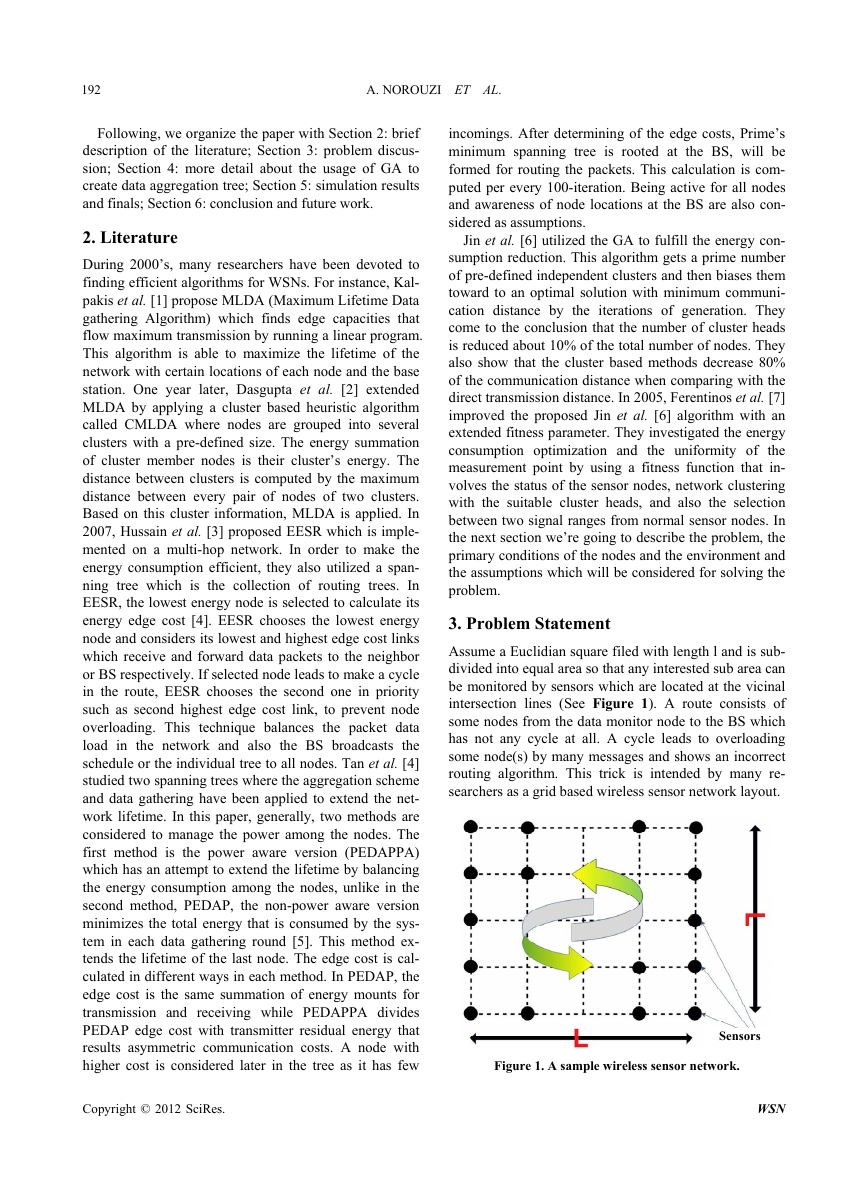
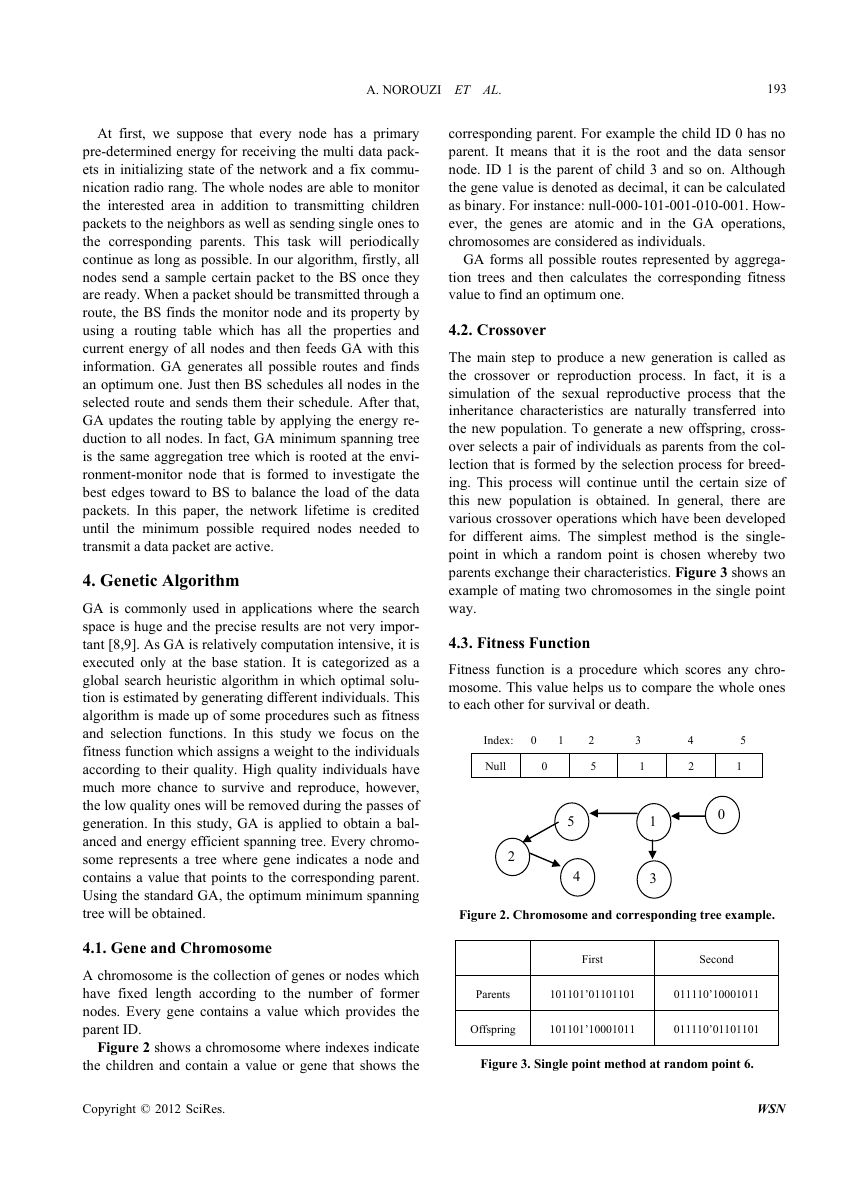
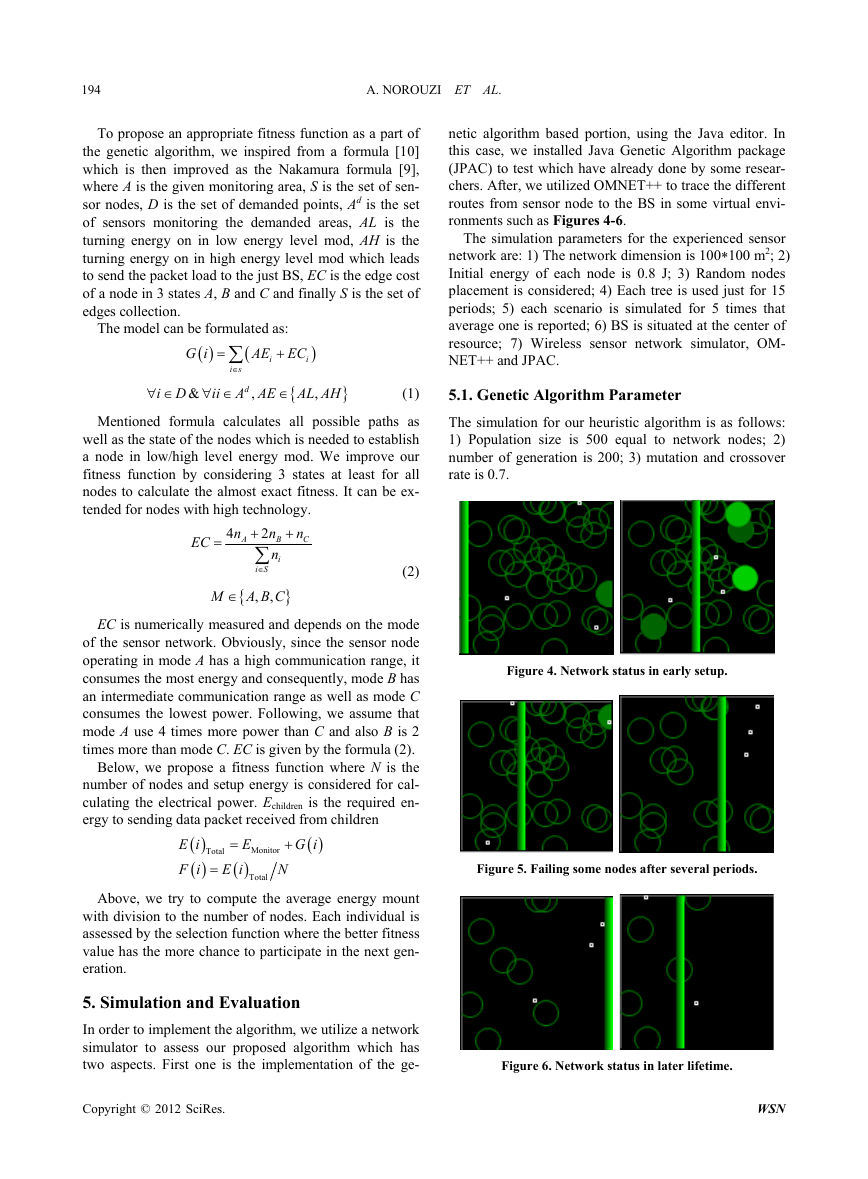
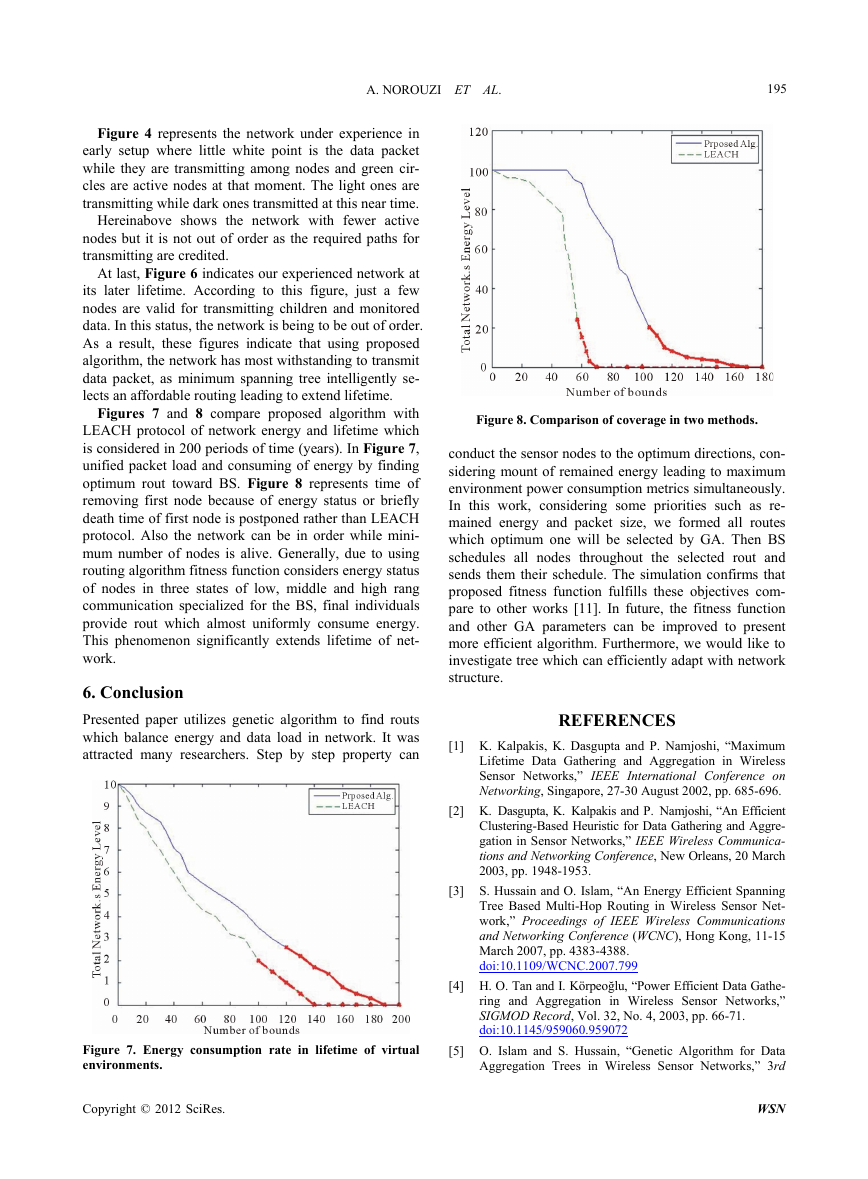
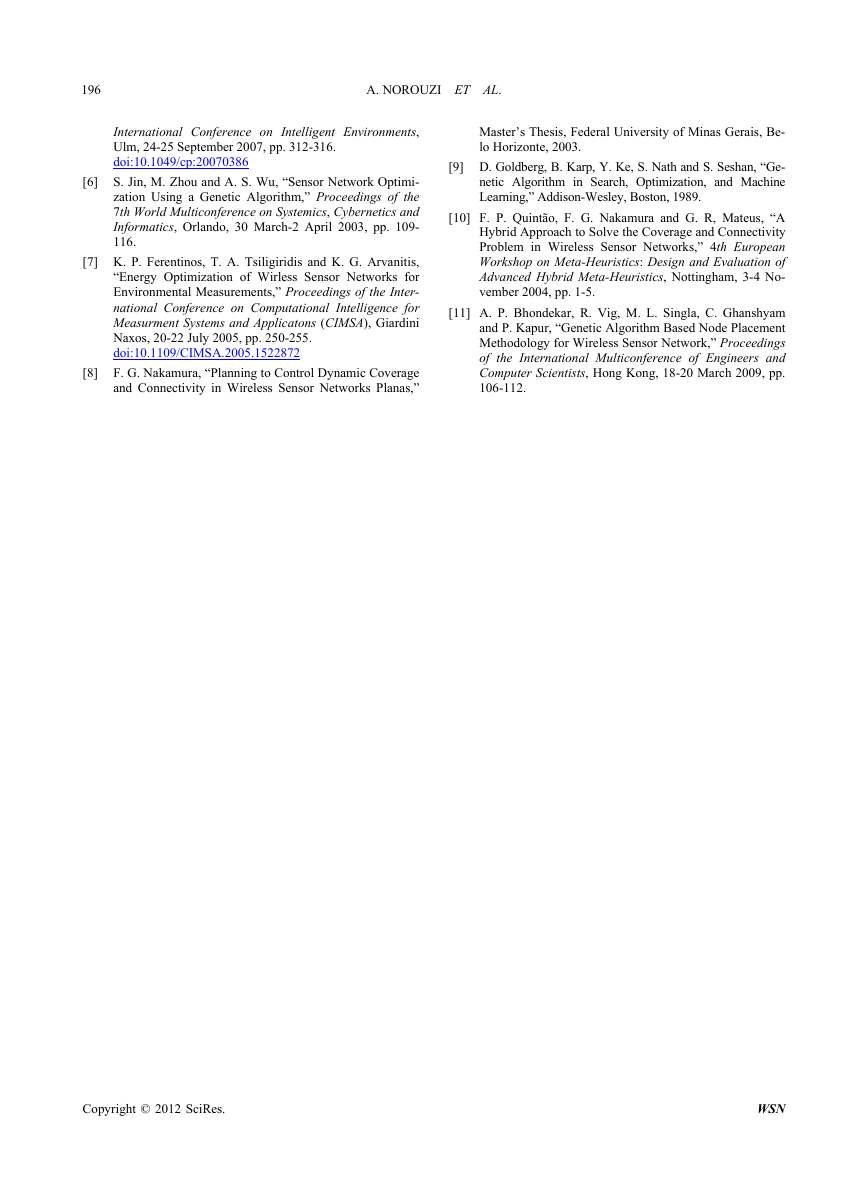






 2023年江西萍乡中考道德与法治真题及答案.doc
2023年江西萍乡中考道德与法治真题及答案.doc 2012年重庆南川中考生物真题及答案.doc
2012年重庆南川中考生物真题及答案.doc 2013年江西师范大学地理学综合及文艺理论基础考研真题.doc
2013年江西师范大学地理学综合及文艺理论基础考研真题.doc 2020年四川甘孜小升初语文真题及答案I卷.doc
2020年四川甘孜小升初语文真题及答案I卷.doc 2020年注册岩土工程师专业基础考试真题及答案.doc
2020年注册岩土工程师专业基础考试真题及答案.doc 2023-2024学年福建省厦门市九年级上学期数学月考试题及答案.doc
2023-2024学年福建省厦门市九年级上学期数学月考试题及答案.doc 2021-2022学年辽宁省沈阳市大东区九年级上学期语文期末试题及答案.doc
2021-2022学年辽宁省沈阳市大东区九年级上学期语文期末试题及答案.doc 2022-2023学年北京东城区初三第一学期物理期末试卷及答案.doc
2022-2023学年北京东城区初三第一学期物理期末试卷及答案.doc 2018上半年江西教师资格初中地理学科知识与教学能力真题及答案.doc
2018上半年江西教师资格初中地理学科知识与教学能力真题及答案.doc 2012年河北国家公务员申论考试真题及答案-省级.doc
2012年河北国家公务员申论考试真题及答案-省级.doc 2020-2021学年江苏省扬州市江都区邵樊片九年级上学期数学第一次质量检测试题及答案.doc
2020-2021学年江苏省扬州市江都区邵樊片九年级上学期数学第一次质量检测试题及答案.doc 2022下半年黑龙江教师资格证中学综合素质真题及答案.doc
2022下半年黑龙江教师资格证中学综合素质真题及答案.doc